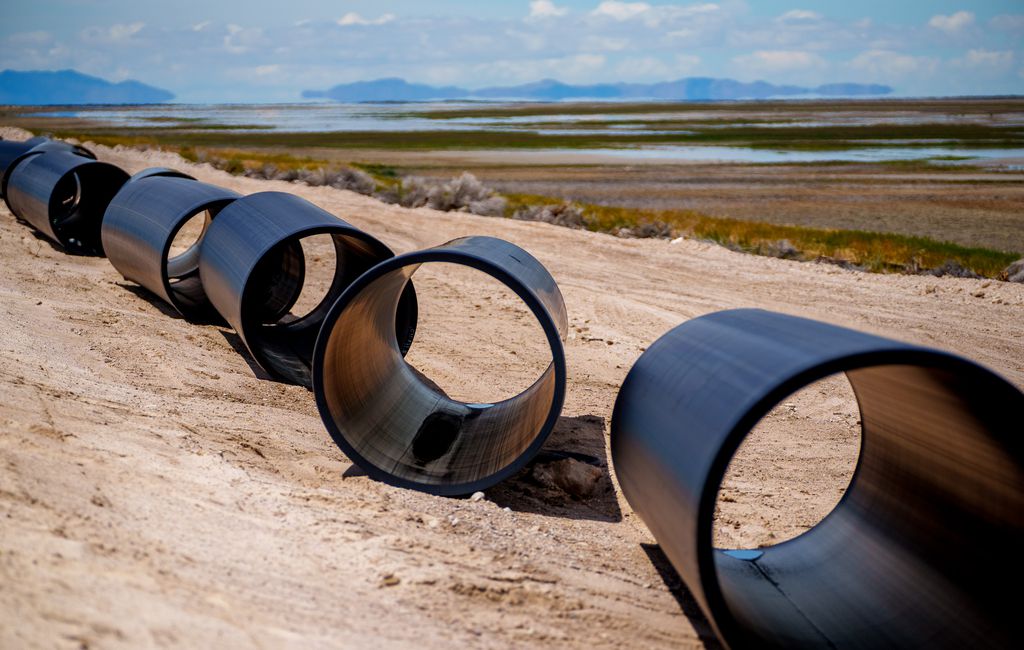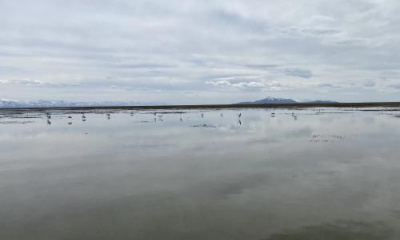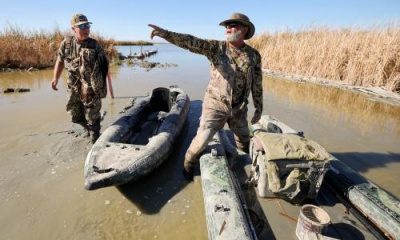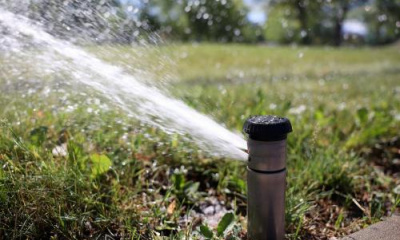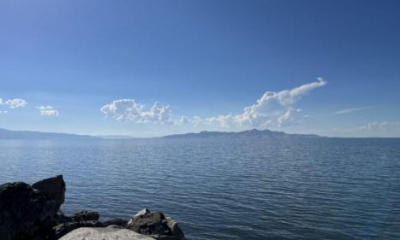A Utah sewer district is saving ratepayers money, cleaning Farmington Bay and providing improved flows to the shrinking lake.
As summer approaches, add toxic algal blooms to the long list of the Great Salt Lake’s troubles stemming from climate change, growth and the Wasatch Front’s unchecked water consumption.
The Great Salt Lake is, after all, the result of whatever water people leave to flow downstream, and it’s poised to hit a record low for the second year in a row. As the lake shrinks and the population swells, a lot more nutrients are running downhill. And with less water to dilute those pollutants, combined with warming temperatures fueled by climate change, dangerous algae and cyanobacteria have proliferated.
But one wastewater treatment plant, which is at least a partial source of Great Salt Lake algal blooms, is offering a creative solution. The North Davis Sewer District is building a six-mile pipeline to discharge its effluent west of Antelope Island, in Gilbert Bay, instead of in the shallower algae-plagued Farmington Bay, where it operates.
“Gilbert Bay is much saltier than Farmington Bay,” said Kevin Cowan, district manager for North Davis Sewer. “It’s salty enough that the harmful algae will not grow.”
The project also could ensure a steady — and improved — stream of water to the lake.
A ‘call to arms’
Nutrient loads are not an issue confined to the Great Salt Lake, the largest water body in the West. Blooms have vexed waters across Utah, from Mantua Reservoir to Utah Lake to Zion National Park. They are so widespread that the state recently updated its limits for phosphorus discharge in treated wastewater.
“There was a call to arms,” said John Mackey, interim director of the Utah Division of Water Quality, “to begin to control nutrients before it became a bigger problem. It’s one of the largest, most expensive problems we face in wastewater treatment today.”
Treatment plants have until 2025 to meet the stricter regulations. Some operators have made big, pricy upgrades in response, including Salt Lake City Public Utilities, which is building a new treatment plant to the tune of $700 million.
But Utah’s new phosphorus limit allows an exception for “innovative alternative approaches,” and water quality regulators determined the North Davis pipeline proposal met those terms.
“It took a lot of thinking and evaluation,” said Mackey. “But really, Gilbert Bay ... doesn’t have the types of environmental issues we’re concerned with.”
The pipeline is about halfway complete, running the length of the Antelope Island Causeway. Its final price tag will come in at around $43 million, Cowan said, saving his ratepayers hundreds of millions by avoiding the need for a new plant.
“In all, it’s a win-win-win,” Cowan said. “It’s a win for the nutrient issue, a win for the district for being the least costly alternative, and a win for the environment.”
Balancing growing demand with a shrinking lake
North Davis serves a population of about 225,000 people in a fast-growing area spanning Weber and Davis counties.
As the Wasatch Front adds more people and Utah’s drought worsens, there’s “growing demand for water,” Jeff DenBleyker, a water resources engineer, said during a presentation about the pipeline at the Great Salt Lake Issues Forum earlier this month.
Municipalities are turning to recycled wastewater — especially now that it’s being treated to a higher standard — as a possible solution.
“When you have a clean water source and you have demand for that water, the water is usually going to flow to where that demand is,” DenBleyker said, especially when communities are shelling out millions to clean it up. “What that means is that their discharge to Great Salt Lake would be eliminated.”
Treating North Davis wastewater to the same standard and piping it to nutrient-limited Gilbert Bay eliminates that pressure, district managers determined.
Beyond ensuring the water continues to flow downstream, the project also creates side benefits for the Great Salt Lake.
Dense stands of invasive phragmites have sprung up along the district’s current discharge canal. The thirsty plants gobble up around a fifth of the 20 million gallons North Davis releases each day, according to Cowan’s calculations, before it flows to the lake.
“This [pipeline] will avoid that situation,” Cowan said. “It will go out where there are no phragmites.”
Salinity varies throughout the lake, which creates different ecosystems. Sections that are close to sources of fresh water, like Bear River Bay, have low concentrations of salt. Farmington Bay, which is currently more of a channel due to the lake’s low elevation, is around 5% salt at normal levels. Gunnison Bay, in the lake’s north arm, is 28% salt or more since it’s virtually cut off from any freshwater sources by a rock-filled railroad causeway.
Brine shrimp in Gilbert Bay depend on nutrient flows from fresher bays, grazing so heavily on the ensuing phytoplankton that the waters become visibly clearer between spring and fall. The pipeline project will ensure those nutrients make it to the shrimp, even as the lake continues to shrink.
“We’ve got ravenous brine shrimp out there,” DenBleyker said, “who would love as many phytoplankton and algae that we can give them.”
In granting the variance to the phosphorus limit, state agencies are requiring North Davis Sewer to mitigate phragmites in Farmington Bay. The district will also conduct ongoing studies of the effluent’s impact on Gilbert Bay, and explore whether managing stormwater surges or occasional outflows to Farmington Bay will benefit the ecosystem and its migrating birds.
“They’ll be able to balance that and move water to one place or both places as the environment requires,” Mackey said. “We’ll still have the ability to be helpful in Farmington Bay, as well as controlling nutrients.”
John Luft, director of the Great Salt Lake Ecosystem Program, has long monitored salinity, brine shrimp and bird populations for the Utah Division of Wildlife Resources. He expressed cautious optimism about the North Davis pipeline project.
“Any water into the lake, at this point — we’ve got to get more water there,” Luft said. “It was beneficial for them and beneficial for us, at least right now. Obviously, if that impairs the water body, we’ll revisit.”

